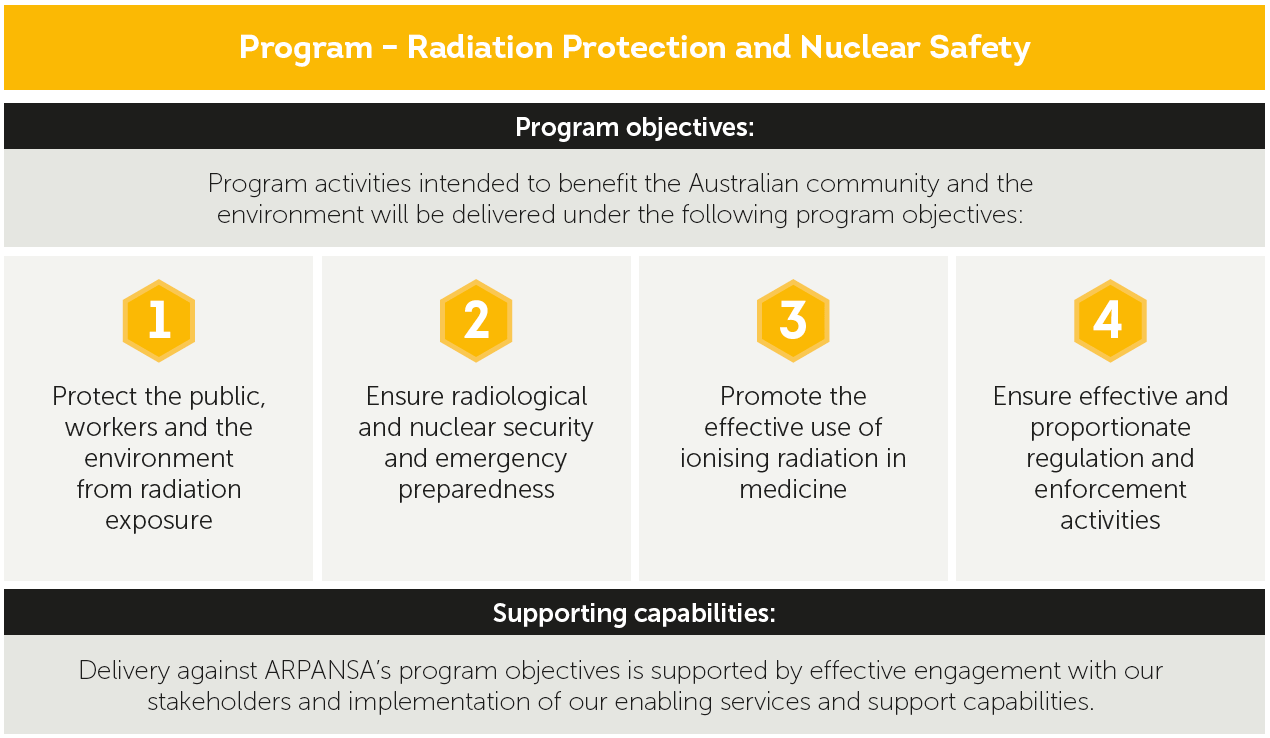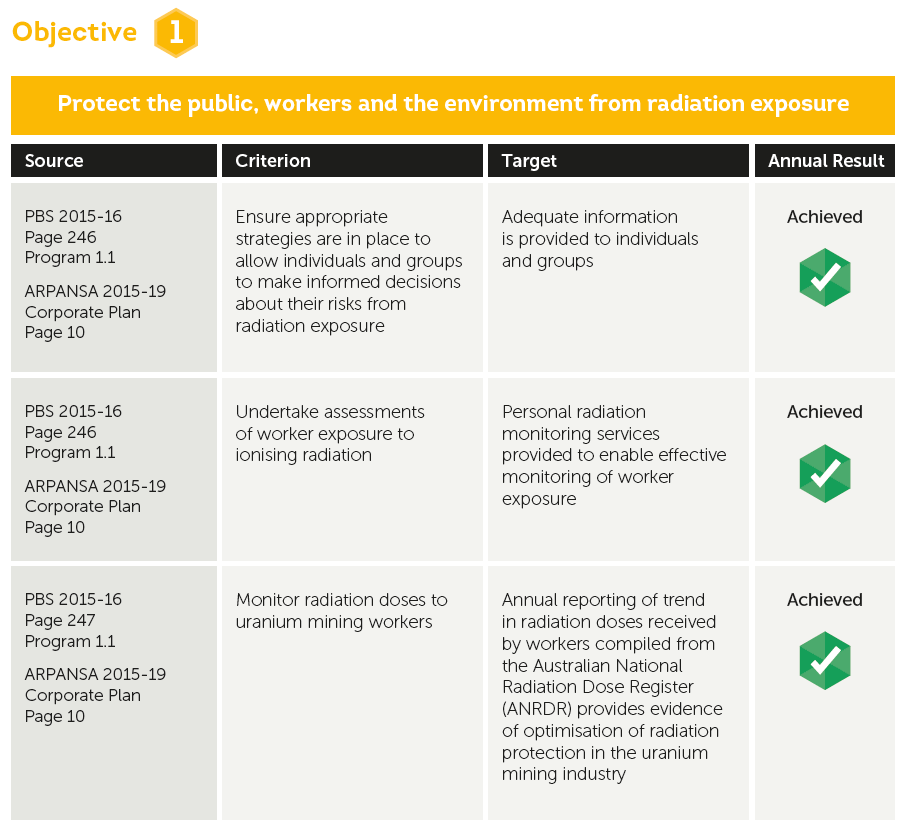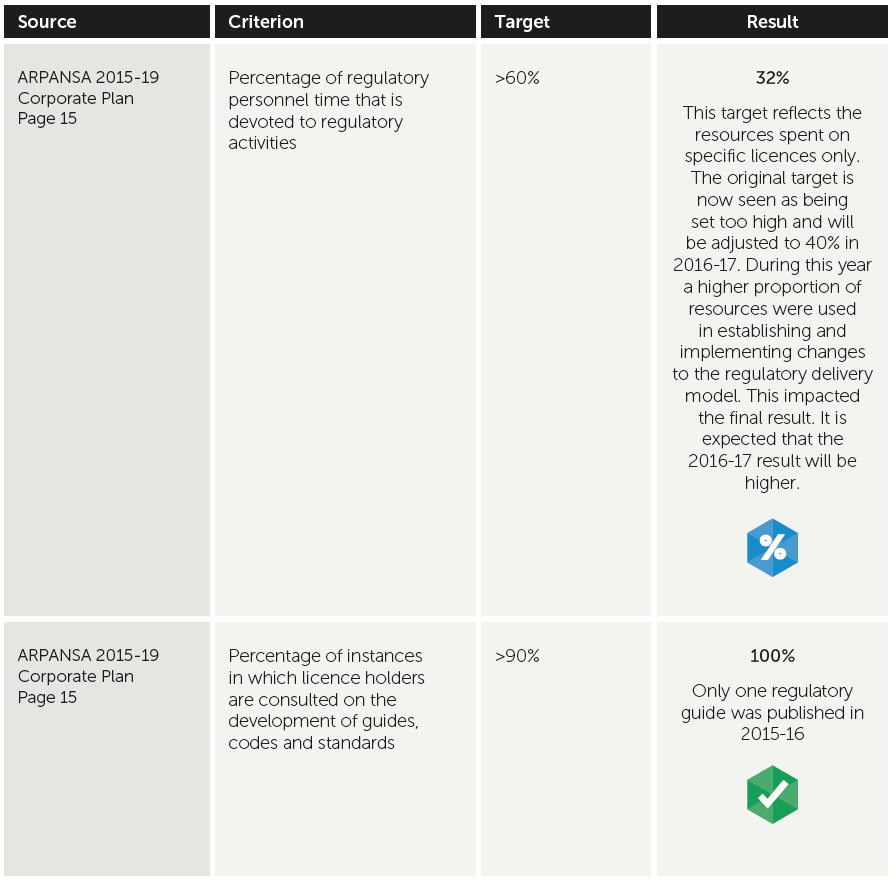Part 3: Report on Performance
ANNUAL PERFORMANCE STATEMENT
Introductory statement
I, Carl-Magnus Larsson, as the accountable authority of the Australian Radiation Protection and Nuclear Safety Agency (ARPANSA), present the 2015-16 annual performance statements (financial and non-financial) of ARPANSA, as required under paragraph 39(1)(a) of the Public Governance, Performance and Accountability Act 2013 (PGPA Act). In my opinion, these annual performance statements are based on properly maintained records, accurately reflect the performance of the entity, and comply with subsection 39(2) of the PGPA Act.
ARPANSA purpose
The Radiation Protection and Nuclear Safety Program, contained within the 2015-16 Portfolio Budget Statements, describes the program objectives which ARPANSA will use to protect the Australian people and the environment from the harmful effects of radiation. The program entails four objectives that guide our priorities and contribute to delivering radiation protection and nuclear safety outcomes to the Australian community. These objectives are supported by whole of entity stakeholder engagement and enabling support capabilities and are described in ARPANSA's 2015-2019 Corporate Plan.


Analysis of performance against purpose and program objective
The following programs have contributed to ARPANSA ensuring that adequate information about radiation exposure is provided to individuals and groups:
- The 'Talk to a Scientist' program delivered high quality real-time and written advice to over 930 members of the public. Over 40 fact sheets and 80 frequently asked questions have been reviewed and maintained on the ARPANSA website.
- The ultraviolet radiation (UVR) monitoring network provided real-time information on the levels of solar UVR in eleven selected cities. During 2015-16 this data has been integrated into the SunSmart app and widget, providing real-time data for all capital city network locations.
- The Ultraviolet Protection Factor (UPF) testing service tested nearly 2000 samples of sun protective clothing, hats, sunglasses and other sun protective materials. Each sample is issued a report, depending on its performance, from UPF10 through to UPF50+. As a result of this testing over three million labels for sun protective products ('swing tags') were issued. These labels enable consumers to see at a glance the UPF for products they are considering purchasing.
- The Personal Radiation Monitoring Service (PRMS) has delivered high quality assessment of worker exposure to ionising radiation services to over 35 000 workers in this reporting period. PRMS has consistently achieved a turnaround time of ten business days for assessment and reporting of dose.
The ANRDR currently holds dose history records for more than 35 000 workers from the uranium mining and milling industry, the mineral sands mining and processing industry and Commonwealth licence holders. An annual analysis of radiation doses received by uranium industry workers was compiled and published in July 2015. This analysis provides evidence that the Australian uranium industry continues to demonstrate optimisation of radiation protection for workers. In 2015-16 ARPANSA extended coverage of the ANRDR to include the CSIRO and has plans to further expand the ANRDR to include occupationally exposed workers in other industries.

Analysis of performance against purpose and program objective
ARPANSA achieved enhanced systems for emergency preparedness and response (EPR) through the following activities:
- providing input to updates of national EPR plans to ensure ARPANSA's roles and responsibilities are identified and better integrated into national planning arrangements
- playing a lead role in reviewing and updating the EPR plans for nuclear powered warship visits to Australian ports
- making progress towards implementing a national radio-analytical laboratory network to strengthen the national response capability to radiological and nuclear emergencies.
Various ARPANSA activities ensure tactical preparedness for a radiological or nuclear incident by:
- maintaining its 24/7 point of contact for stakeholders to report and/or request ARPANSA assistance with >95% availability
- testing the effectiveness of ARPANSA's EPR systems for field, network and laboratory measurements
- participating in International Atomic Energy Agency international exercises, known as ConvEx, to test the coordination and communication of information and requests for advice and assistance for a hypothetical situation
- conducting internal exercises to test elements of ARPANSA's Incident Management Plan and participating in one multi-jurisdiction, multi-agency exercise to test the Department of Health's Chemical, Biological, Radiological or Nuclear Incident Plan
- participating in an international field workshop in Japan, enabling testing of ARPANSA's Response and Assistance Network (RANET) functional areas of in-situ gamma spectrometry and mobile monitoring, and exercising ARPANSA's externally based support in data analysis and GIS products
- maintaining laboratories which passed national and international assessments designed to test our proficiency at the measurement of a range of radionuclides in different sample types
- operating seven particulate radionuclide monitoring stations and two noble gas monitoring stations that form part of the Comprehensive Nuclear-Test-Ban Treaty Organization International Monitoring System
with >95% data availability.

Analysis of performance against purpose and program objective
ACDS audits have resulted in over ninety recommendations to Australian clinics which have led to changes in equipment and clinical practice. With 95% of Australian radiotherapy providers participating in this audit program, the ACDS is in the unique position of being able to collect and analyse large quantities of data, which is essential to truly understanding the safe and effective use of ionising radiation in medicine.
All radiation therapy delivered in Australia is based on the assumption that the dose being delivered to the patient is correct. Dose calibrations performed by ARPANSA on the National Medical Linac ensure that the equipment within each hospital is calibrated correctly and that ARPANSA is contributing to the safety of the patient.
The single greatest contribution to the total human exposure to ionising radiation within Australia is that delivered by medical uses, particularly computed tomography (CT) scanning. ARPANSA's Diagnostic Reference Level service establishes benchmarks that allow imaging facilities to compare their ionising radiation metrics for common procedures with those of their peers. Imaging providers are thus alerted to opportunities to further optimise their technique by reducing the dose for a procedure whilst maintaining the image quality necessary for the diagnostic task.

Analysis of performance against purpose and program objective
ARPANSA has fulfilled its obligations under the government's Portfolio Budget Statement and Regulator Performance Framework by applying a risk informed regulatory regime based on active communication with the licence holder and with a compliance monitoring and enforcement system that does not unnecessarily impede the operation of regulated entities.
Achievement of the targets for the six KPIs described below is aimed at maximising ARPANSA's ability to deliver regulatory services that are effective and proportionate. This is the first year of experience with the use of these targets and in many cases ARPANSA has met or exceeded them. In other cases it has become necessary to revise the targets so that they are more realistic in terms of being achievable.
These results demonstrate that ARPANSA has contributed to the efficient operation of regulated entities by adhering to the established inspection schedule and assessing applications within the timelines agreed with licence holders. Furthermore, these results provide evidence that ARPANSA's regulatory regime is based on active communication with licence holders and demonstrate that information sharing is an effective way to reinforce regulatory expectations and well as provide more effective regulatory oversight and understanding of licence holder operations.
The following summarises ARPANSA's performance in relation to the Regulator Performance Framework.
REGULATOR PERFORMANCE FRAMEWORK KPIs 1 2
KPI 1 — Regulators do not unnecessarily impede the efficient operation of regulated entities

1 The government's Regulator Performance Framework requires regulatory agencies to develop output or activity-based evidence metrics for each of six Key Performance Indicators (KPI) in the Framework.
2 The Regulator Performance Framework KPIs, which were approved by the Minister, are aspirational in nature and the associated numerical goals are aimed at stretching performance toward excellence.
KPI 2 — Communication with regulated entities is clear, targeted and effective

KPI 3 — Actions undertaken by regulators are proportionate to the regulatory risk being managed

KPI 4 — Compliance and monitoring approaches are streamlined and coordinated

KPI 5 — Regulators are open and transparent in their dealings with regulated entities

KPI 6 — Regulators actively contribute to the continuous improvement of regulatory frameworks

SUPPORTING CAPABILITY – STAKEHOLDER ENGAGEMENT

Analysis of performance against purpose and program objective
Advice to the Minister and the Australian Government is relevant, accurate and evidence-based. The consistent and timely provision of this advice allows these decision-makers to be properly informed of current, emerging and potential issues relating to protecting Australia's people and environment from radiation.
ARPANSA achieves these targets through regular interaction with the minister's office, including the provision of weekly updates on topical issues. ARPANSA is also a well regarded and an active contributor to a variety of inter-departmental committees and steering groups.


